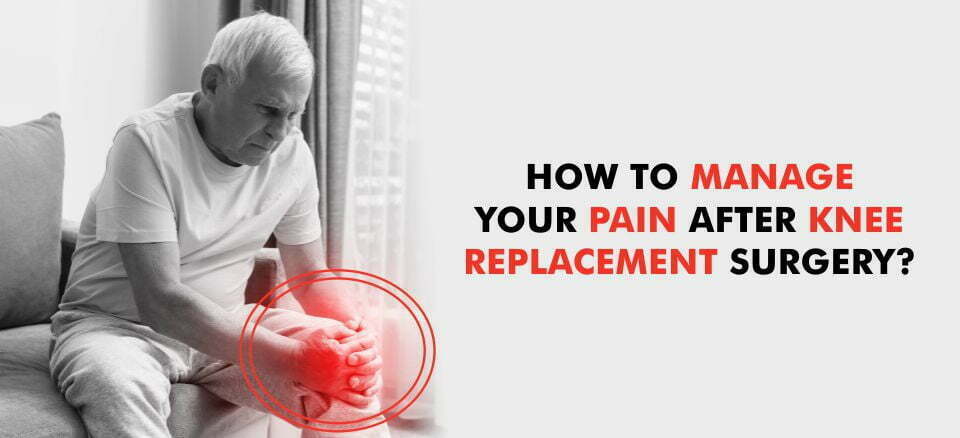


[vc_row][vc_column][vc_column_text]One of the biggest concerns for patients undergoing knee replacement surgery is: Will I be able to handle the pain after the surgery?
The truth about knee replacement surgery is that people undergoing this procedure will face varying degrees of pain after the surgery. However, a person can follow some essential ways to manage postoperative symptoms and ease their recovery.
After the initial swelling and pain, most the patients will see a dramatic improvement in their knee issues within weeks of having a knee replacement procedure. This is because the team of orthopaedic experts and nurses uses various methods and medicines to ensure comfort for the patient.
Healthcare experts or professionals utilise a bundle of treatments before, during, and after the replacement procedure to control inflammation and pain.
These methods include local anaesthetic injections, various types of nerve blocks, and pain medicines, such as multimodal analgesia. These methods provide pain relief and help reduce the length of a person’s hospital stay.
Knee replacement pain is a major postoperative issue for patients who are about to have a replacement operation. Every patient wants to know about their postoperative life, how much pain or discomfort they will have, and how many medicines they will have to take after undergoing a knee replacement surgery.
Educating yourself about pain can significantly reduce fears or myths and help you manage your expectations.
According to the American Academy of Orthopaedic Surgeons (AAOS), common knee replacement pain management medicines or procedures include:
Ice and elevation of the leg will play a vital role in reducing swelling and pain during the recovery time. Therefore, people should utilise a cloth-wrapped ice pack on the swollen part for 20 minutes every 3–4 hours when possible.
Gentle physical exercises after the knee replacement may also reduce inflammation and the risk of blood clots.
To lower the risk of inflammation and blood clots, orthopaedic experts suggest a blood thinner for a fixed time after the procedure. Other useful devices after knee replacement surgery include compression boots and support or compression stockings.
Post-orthopaedic surgery pain management also involves performing physical therapies or knee exercises. These can speed up the recovery rate and decrease postoperative pain. Most people can start knee movement within hours of the surgery.
A physical therapist will guide you through some specific exercises that help strengthen the knee and restore its health. They may suggest performing essential exercises for 20–30 minutes at a time, two to three times daily, as well as walking for 30 minutes two or three times a day.
Some examples of postoperative exercises include:
Tighten the thigh muscle and try to straighten the affected knee. Stay in this position for 5–10 seconds.
Try to tighten the thigh muscle with the operated knee fully straightened on the bed. Lift the leg a few inches off the bed and hold the position for 5–10 seconds.
Move the foot up and down using the calf and shin muscles.
Place a small rolled-up towel just above the heel, tighten the thigh, and try to straighten the knee fully so that the back of the knee touches the surface.
The primary function of the kidneys to flush out the toxins and impurities from the body gets disrupted when it gets infected. The process of excreting wastes is hindered when this function of the kidney gets impaired.
This leads to the build-up of toxins, excess water & salt in several body tissues. Ultimately the ankle, legs, hands, face, and feet, all end up getting swollen.
Severe malfunctioning can lead to retention of water in the lungs as well, which leads to shortness of breath. Prolonged puffiness in the eyes is also a sign that indicates that your kidney may be in danger.
After the surgery, you can continue wearing compression stockings that can reduce the risk of developing a blood clot and may prevent aching in the leg.
Another home remedy is elevating the operated leg above the level of the heart periodically during the day.
Some topical creams and patches can also reduce knee pain and make it comfortable for you to sleep at night. These usually include menthol, capsaicin, or salicylates. Patients commonly utilise these ingredients in the operated area to ease the pain.
The knee replacement surgery affects each patient differently. Some people face some pain, inflammation, and bruising after the procedure.
Discuss your level of pain with your orthopaedic doctor or knee replacement surgeon and report any abrupt changes. Using medicines, ice packs, elevation, and physical exercises can reduce discomfort and speed up recovery. Only highly skilled and experienced doctors can assure after knee surgery pain relief.
You should consult the best team of orthopaedic experts at Amandeep Hospital as soon as possible if your severe pain persists. We strive to provide maximum possible pain relief after knee replacement.
Amandeep Hospital, the best orthopedic hospital, is committed to changing and improving patients’ lives by serving exceptional orthopedic care through innovative technology, ongoing research, high-quality services, and cost-effective treatments.
Our highly trained knee replacement surgeons take complete responsibility for the patient’s care and health so that they can live a pain-free life.
Don’t live in pain! Connect with our experts today.[/vc_column_text][/vc_column][/vc_row]
September 30, 2024
Recognize the Signs: Understanding Appendicitis Pain Symptoms
September 24, 2024
Unveiling the Truth: I-Pill Side Effects Every Woman Should Know
We use cookies to enhance your experience. By clicking "Accept", you agree to our use of cookies.